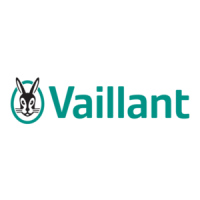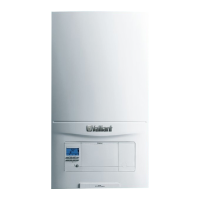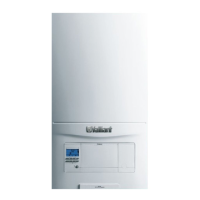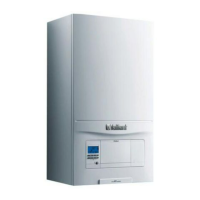Do you have a question about the Vaillant ecoFIT sustain 415 and is the answer not in the manual?
Defines the product's designed purpose and prohibited uses to ensure safe operation.
Specifies the required training and competence for individuals performing installation and maintenance.
Details essential safety guidelines covering gas, flue gas, electricity, and other hazards.
Explains the CE marking and its significance regarding product compliance with directives.
Mentions Vaillant's membership in the Hot Water Association and where to find details.
Describes the identification plate and the information it contains about the product.
Identifies and illustrates the main functional components of the boiler unit.
Details the built-in safety devices and their functions, including frost protection and condensate blockages.
Ensures all necessary components are present and intact upon delivery.
Illustrates the product's external dimensions with clear graphical representation.
Specifies suitable and unsuitable locations for installing the boiler, including room requirements.
Defines the necessary clearances around the product for safe installation and maintenance access.
Covers regulations and requirements for the installation of the air/flue pipe system.
Details regulations for flue outlet configurations and the importance of the correct fall.
Provides critical guidelines for the correct and safe positioning of the air/flue terminal.
Describes different types of flue configurations and their installation requirements.
Instructions on using the template for accurate hole drilling during wall mounting.
Details the steps and considerations for securely mounting the boiler onto a wall.
Step-by-step guide for safely removing and refitting the boiler's front casing.
Procedure for removing and reinstalling the side section for maintenance access.
Completes the procedure for reinstalling the boiler's side section after maintenance.
Checks and preparations required before commencing the boiler installation process.
Instructions for correctly installing the heating pump, including pressure loss considerations.
Details on connecting the boiler to an open vented heating system, including pipework.
Guidance for connecting the boiler to a sealed heating system, including safety valve requirements.
Steps for correctly connecting the heating flow and return pipes to the boiler.
Ensures the boiler is compatible with the available natural gas type at the installation site.
Procedure for establishing a safe and compliant gas connection to the boiler.
Instructions for correctly installing the condensate discharge pipe, considering regulations and frost.
Details various methods for discharging condensate, including direct and external connections.
Guidelines for installing the air/flue pipe system, including room-sealed requirements.
Specific steps for installing and connecting the air/flue pipe, noting requirements for damp rooms.
Crucial safety and procedural information for carrying out the electrical installation.
Procedure for safely accessing the boiler's electronics box for wiring.
Guidance on routing connection cables correctly within the boiler's electronics compartment.
Detailed instructions on making electrical connections to the boiler's control system.
Steps for safely connecting the boiler to the mains power supply, including isolation.
Instructions for connecting the heating pump to the boiler's control system.
Guidance on connecting external controls like thermostats and sensors to the boiler's electronics.
Overview of how the boiler operates and its main user interface functions.
Introduction to the installer level interface for accessing settings and diagnostics.
Step-by-step guide on how to access the installer level for advanced functions.
Describes how to view the product's current operating status using live monitor codes.
Guidance on utilizing diagnostic check programmes for testing specific boiler functions.
Procedures for the initial commissioning of the boiler using the benchmark checklist.
Critical steps for ensuring water quality and treating system water for optimal performance.
Instructions for correctly filling the condensate trap to prevent gas escape.
Simple instruction on how to switch on the boiler using its main switch.
Detailed steps for flushing the heating system with cold water before initial operation.
Procedure for filling the heating installation with water at the maximum possible volume flow.
Covers checking and verifying gas settings, flow rates, and pressure for correct operation.
Ensures the air/flue system is correctly installed and checks for potential flue gas recirculation.
Procedure to verify the gas flow rate is within specified limits during operation.
Critical check of the gas inlet pressure to ensure correct and safe operation.
Verifies the combustion efficiency by measuring the CO2 content in the flue gas.
Instructions for a final hot flush of the heating system after initial cold flush.
Ensures all connections, including gas and water circuits, are properly sealed.
Procedure to verify the boiler is operating correctly in its intended heating mode.
Explains the burner anti-cycling function and how to set its duration to prevent short cycling.
Instructions for completing the service record after maintenance activities.
Emphasizes the importance of using only original seals for replacement parts.
Adherence to recommended schedules for inspection and maintenance to ensure longevity.
References to a detailed list of inspection and maintenance tasks found in the appendix.
Procedure for checking and adjusting the CO2 content for optimal combustion efficiency.
Steps for safely removing the gas-air mixture unit for maintenance or replacement.
Instructions for cleaning the heat exchanger to maintain optimal heat transfer efficiency.
Procedure for inspecting the burner for damage and ensuring its proper function.
Steps for checking the ignition electrode's condition and correct gap setting.
Guidance on how to clean the condensate trap to prevent blockages.
Instructions for correctly installing the gas-air mixture unit after maintenance.
Final checks and documentation required after completing inspection and maintenance tasks.
Steps to identify and resolve fault messages (F.xx) displayed by the product.
How to access and clear the stored fault history within the product's memory.
Procedure for restoring the product's settings to their original factory default values.
Essential safety precautions and preparation steps before undertaking any repair work.
Detailed instructions for replacing various defective parts of the boiler.
Step-by-step guide for removing and replacing the burner unit.
Instructions for removing and installing a new gas-air mixture unit.
Procedure for safely removing and replacing the heat exchanger.
Guidance on how to replace the main printed circuit board (PCB).
Instructions for replacing the PCB related to the user interface.
Final check to ensure the product and its connections are leak-tight after servicing.
A table detailing required inspection and maintenance tasks and their intervals.
Lists and explains various diagnostic codes used to monitor and control the boiler's functions.











